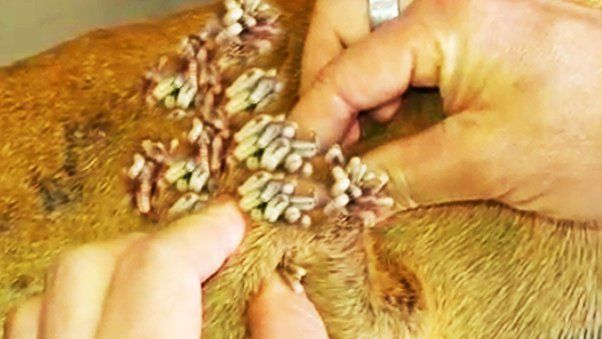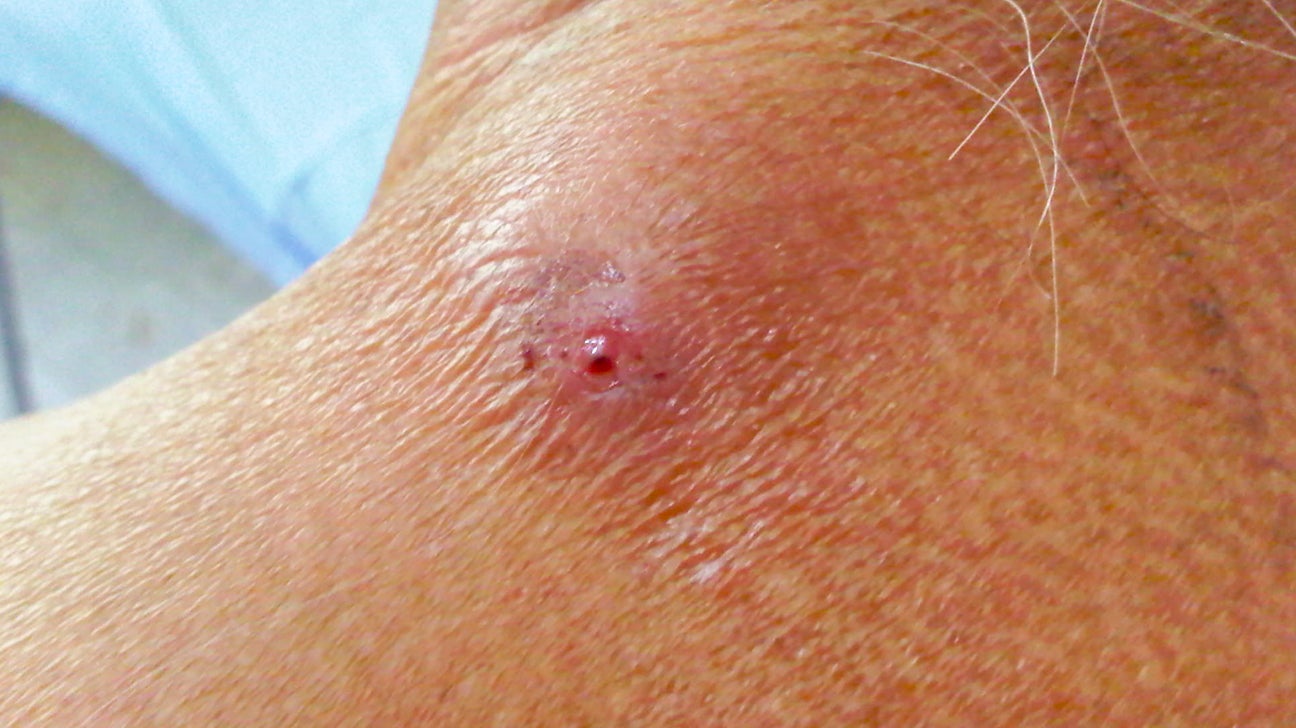
The larva of mango flies can burrow under the skin of mammals, including people and pets like dogs. They live under the skin until they mature into adults and burst out of the skin.
Mango flies (Cordylobia anthropophaga) are a species of blow fly that’s native to certain parts of Africa, including South Africa and Uganda. These flies have several names, including putsi or putzi fly, skin maggot fly, and tumbu fly.

The larvae of mango flies are parasitic. This means they get under the skin of mammals, including humans, and live there until they’re ready to hatch into maggots. This type of parasitic infestation in a person is called cutaneous myiasis.
Keep reading to learn how to avoid becoming a host to mango fly larvae if you live or travel to parts of the world where they can be found in large numbers.
We’ll also tell you what an infestation looks like and what to do if one or more mango fly eggs get under your skin.

Adult maggots burst out of boils in the skin
As the larvae continue to mature into adult maggots, the boil will start to fill with pus. It may be possible to see or feel the larvae wiggling under the skin during this time.
When larvae are fully matured, they burst out of the skin and fall off. As fully formed maggots, they continue to grow into maggot flies over a three-week period.
Mango fly infestation is common in tropical parts of Africa. It’s less likely to occur in other regions. This is, however, not unheard of, since larvae may be accidentally transported in baggage on airplanes or boats.
Dogs and rodents are the most common hosts for mango flies. Humans can also become infected if precautions aren’t put in place. Infestation occurrences may escalate after periods of intense rainfall, affecting greater numbers of people.
Once mango fly larvae penetrate the skin, it may take several days for symptoms to start. These include:
- Mild to intense itching. Some people experience only a vague sense of skin discomfort. Others feel very intense, uncontrollable itching. The number of larvae may determine how itchy you feel.
- Discomfort or pain. As the days go by, pain, including intense pain, may occur.
- Blisterlike lesions. Pimples will start to form within a few days of infestation. They start looking like red dots or mosquito bites then turn into hard boils within two to six days. The boils continue to increase to about 1 inch in size as the larvae grow. They’ll have a tiny air hole or black dot on top. This dot is the top of a tracheal tube through which the larvae breathe.
- Redness. The area of skin surrounding each boil may be red and inflamed.
- Sensations under the skin. You may feel or see the larvae wiggling in each boil.
- Fever. Some people start to run a fever days or weeks after infestation occurs.
- Tachycardia. Your heart may race at a higher rate.
- Insomnia. Trouble sleeping and difficulty concentrating may occur as a response to pain and intense itching.

It’s possible to remove mango fly larvae yourself, although the process may be more comfortable and effective when done by a doctor.
If your pet is infected, seek the support of a veterinarian.
There are several techniques for removing mango fly larvae:
Hydraulic expulsion
A doctor will inject each boil with lidocaine and epinephrine. In most cases, the force of the fluid will push the larvae out completely. In some instances, the larvae will need to be lifted out with forceps.
Suffocation and pressure
Remove any scab that appears on the top of the lesion. You may be able to rub it off with oil.
To cut off the larvae’s air supply, you can cover the black dot on top of the boil with petroleum jelly or wax. The larvae may start to crawl out to seek air. At this point, you can remove them with forceps.
Squeeze and eject
If the larvae do crawl out, it may be necessary to increase the size of the hole. You can eject them by gently pushing each side of the boil together, squeezing them out. Forceps may also help eject them.
It’s important to remove the larvae in one piece so no tiny remnants remain under the skin. This can cause infection.
If you live or travel to areas that have mango flies, you can avoid infestation by taking these precautions:
- Don’t dry washed clothing, bedding, or towels outdoors or in areas that have open windows. If this is unavoidable, iron everything on high heat before wearing or using. Make sure to pay special attention to the seams of fabric.
- If possible, only wash and dry your clothing in washing machines and dryers on high heat.
- Don’t use items, such as backpacks or clothing, that have been left on the ground.
Seeing a doctor for mango fly infestation as quickly as possible will help reduce the risk of infection and end your discomfort more quickly. A doctor can also inspect your entire body for areas of infestation. They can more easily distinguish mango fly larvae boils from minor insect bites.
Keep in mind it’s possible to have multiple sites of infestation in areas of your body that you can’t see or treat on your own. It’s also possible to have boils in multiple stages of infestation. A doctor will be able to remove them all and eliminate your risk for complications.
No matter how the larvae are removed, infection is possible. You can avoid getting an infection by rinsing out the area completely with an antibiotic liquid. Use topical antibiotics until the wound is completely cleared and no redness appears on the skin.
Change the dressing daily, and reapply antibiotic ointment. In some instances, your doctor might also prescribe oral antibiotics for you to take.
Mango fly infestation is common in parts of Africa. Dogs and rodents are most likely to be affected, but humans also make good hosts for mango fly larvae.
A doctor can completely and easily remove larvae. It’s important to treat them early to avoid complications such as tachycardia and infection.

:max_bytes(150000):strip_icc():focal(721x269:723x271)/tooth-in-eye-surgery-091325-26999b6c64f14d2ba72d4306a52a8d19.jpg?w=1200&resize=1200,0&ssl=1)







:max_bytes(150000):strip_icc():focal(749x0:751x2):format(webp)/Vencent-Hickerson-111925-6-f70136ab95854fed905274e761d98e0f.jpg?w=1200&resize=1200,0&ssl=1)
































